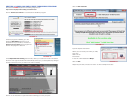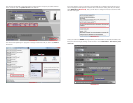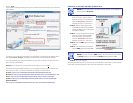
Click on Begin.
If you receive a message stating that the port is online and can be reached, then you have set
it up correctly.
To connect to your DVR from the Internet, you will need to put the Internet IP address shown
after “Your Internet Address:” message into the browser or access program window.
If you are forwarding any other port instead of port 80, then you need to put that port’s num-
ber at the end of the address.
Example: if you use port 85, you will need to enter: http://75.14.251.43:85
Instructions for using the ASee software on your smartphone can be found on the CD that
came with your DVR, or it can be downloaded by clicking on the links below:
Android: http://q-see.com/files/DeviceFiles/R-AndroidSetupNewweb.pdf
Blackberry: http://q-see.com/files/DeviceFiles/R-Smart Phone Access Blackberry.pdf
iPhone: http://q-see.com/files/DeviceFiles/R-Smart Phone Access iPhone.pdf
Symbian: http://q-see.com/files/DeviceFiles/R-Smart Phone Access Symbian.pdf
Windows Mobile:
http://q-see.com/files/DeviceFiles/R-Smart Phone Access Windows Mobile.pdf
PICTURE 20
SECTION 4: SETTING UP DMZ IN ROUTER 2
NOTE! You will only need to proceed with this section if you detected a
second router in Section 2.
NOTE! If you do not have a DMZ setting in the router, check to see if there
is a Bridge setting. If so, then use the Bridge setting instead of DMZ.
STEP 1. Login into Router 1 by putting
the IP of Router 1 into the Internet
Explorer browser, as in the example
shown in Picture 21 where the IP
address of Router 1 is 192.168.0.1
STEP 2. Find the status page on the
router settings that shows the WAN/
Internet IP address and write it down
this WAN IP address.
STEP 3. Log into the Router 2 by putting
the IP of Router 2 into the Internet
Explorer browser, as in example
shown in Picture 21 where the IP
address of Router 2 is 192.168.1.1
STEP 4. Find the DMZ page in the router
settings.
STEP 5. Enter the WAN IP for Router 1
into the DMZ page and enable DMZ.
PICTURE 21
STEP 6. Save your changes.
You have forwarded the ports on the router to which the DVR is connected, to the IP address
of the DVR, and set the primary router to pass the connection to this router.







